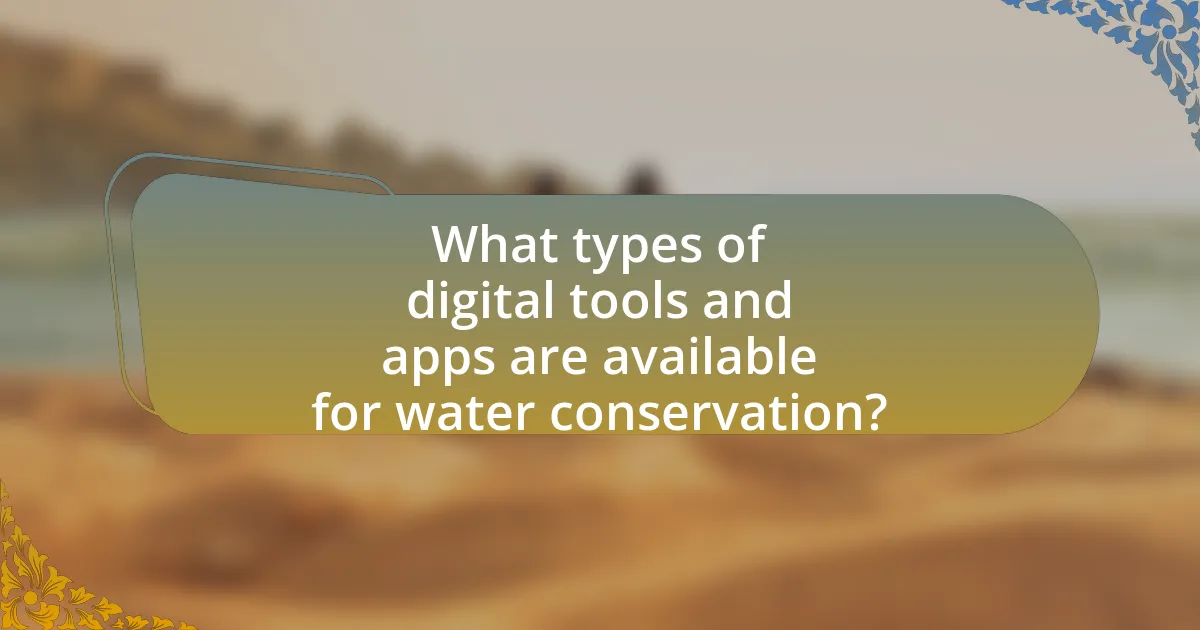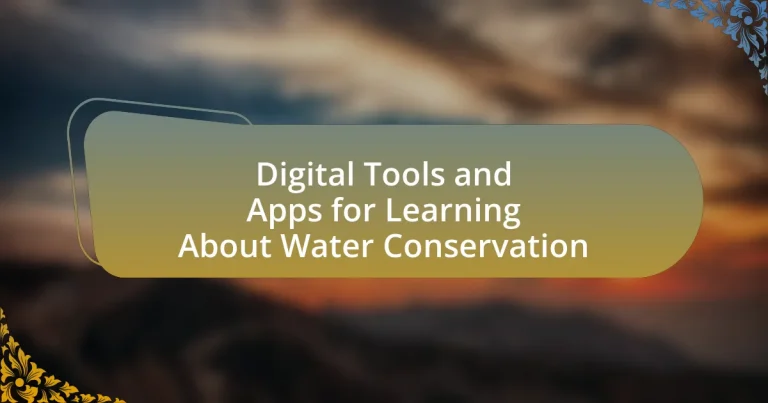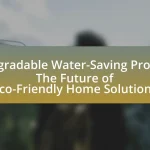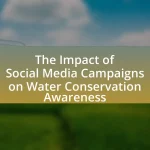Digital tools and apps for learning about water conservation play a crucial role in promoting sustainable water use. Platforms such as WaterSmart, Dropcountr, and the EPA’s WaterSense program provide users with personalized insights, tracking capabilities, and educational resources to enhance their understanding of water consumption and conservation practices. These tools utilize interactive features, real-time data, and gamification to engage users effectively, leading to significant reductions in water usage. The article explores the various types of digital tools available, their effectiveness in education, user interface impacts, and strategies for maximizing their benefits in water conservation efforts.

What are Digital Tools and Apps for Learning About Water Conservation?
Digital tools and apps for learning about water conservation include platforms like WaterSmart, Dropcountr, and the EPA’s WaterSense program. WaterSmart provides personalized water usage reports and conservation tips, helping users understand their consumption patterns. Dropcountr offers a mobile app that tracks water usage and provides insights on how to reduce waste. The EPA’s WaterSense program features educational resources and tools to promote water-efficient practices. These tools are designed to enhance awareness and encourage sustainable water use, contributing to overall conservation efforts.
How do these tools and apps contribute to water conservation education?
Digital tools and apps significantly enhance water conservation education by providing interactive and engaging platforms for users to learn about water usage and conservation practices. These tools often include features such as real-time data tracking, educational games, and personalized tips, which help users understand their water consumption patterns and the impact of their actions on water resources. For instance, studies have shown that apps like WaterSmart can lead to a reduction in household water use by up to 20% by educating users on efficient practices and encouraging behavioral changes. Additionally, these digital resources often incorporate gamification elements, making learning about water conservation more appealing and effective, particularly for younger audiences.
What features make these tools effective for learning?
Digital tools and apps for learning about water conservation are effective due to their interactive features, accessibility, and data-driven insights. Interactive features, such as quizzes and simulations, engage users actively, enhancing retention of information. Accessibility allows learners to access resources anytime and anywhere, catering to diverse learning styles and schedules. Data-driven insights provide real-time feedback and personalized learning experiences, which have been shown to improve understanding and application of water conservation practices. For instance, studies indicate that interactive learning environments can increase knowledge retention by up to 75%, demonstrating the effectiveness of these tools in promoting water conservation education.
How do user interfaces impact the learning experience?
User interfaces significantly impact the learning experience by influencing user engagement, comprehension, and retention of information. A well-designed user interface enhances usability, making it easier for learners to navigate digital tools and apps, which is crucial for effective learning. Research indicates that intuitive interfaces can lead to a 30% increase in task completion rates and a 25% improvement in user satisfaction, as reported in a study by Nielsen Norman Group. Furthermore, interfaces that incorporate visual aids and interactive elements can facilitate deeper understanding, as they cater to various learning styles and promote active participation. Thus, the design and functionality of user interfaces play a critical role in shaping how effectively learners interact with educational content.
Why is it important to use digital tools for water conservation?
Using digital tools for water conservation is important because they enhance efficiency in monitoring and managing water resources. These tools, such as smart irrigation systems and water usage tracking apps, provide real-time data that help users make informed decisions about water consumption. For instance, a study by the Water Research Foundation found that smart irrigation systems can reduce water usage by up to 30% while maintaining landscape health. This demonstrates that digital tools not only promote sustainable practices but also lead to significant water savings, making them essential for effective water conservation efforts.
What role does technology play in promoting environmental awareness?
Technology plays a crucial role in promoting environmental awareness by providing accessible platforms for education and engagement. Digital tools and applications facilitate the dissemination of information about environmental issues, enabling users to learn about water conservation practices effectively. For instance, apps like WaterWise and Dropcountr help users track their water usage and offer tips for reducing consumption, thereby fostering a culture of conservation. Research indicates that interactive technology can enhance learning outcomes; a study published in the Journal of Environmental Education found that students using digital tools demonstrated a 30% increase in knowledge retention regarding environmental topics. This evidence underscores the effectiveness of technology in raising awareness and encouraging proactive environmental behaviors.
How can digital tools reach a wider audience compared to traditional methods?
Digital tools can reach a wider audience compared to traditional methods by leveraging the internet’s global connectivity and the ability to share content instantly across multiple platforms. Unlike traditional methods, which often rely on physical distribution and localized outreach, digital tools can disseminate information to millions of users simultaneously through social media, websites, and mobile applications. For instance, a study by the Pew Research Center found that 90% of adults in the U.S. use the internet, highlighting the vast potential audience accessible through digital means. Additionally, digital tools allow for targeted marketing and personalized content delivery, enhancing engagement and reach.

What types of digital tools and apps are available for water conservation?
Various digital tools and apps are available for water conservation, including smart irrigation systems, water usage tracking apps, and educational platforms. Smart irrigation systems, such as Rachio and RainMachine, optimize watering schedules based on weather data, reducing water waste. Water usage tracking apps like WaterMinder and My Water Footprint help users monitor their daily water consumption, providing insights to encourage conservation. Educational platforms, such as the Water Conservation Toolkit by the EPA, offer resources and tips for effective water-saving practices. These tools collectively contribute to more efficient water management and increased awareness of conservation efforts.
What categories of apps exist for learning about water conservation?
Categories of apps for learning about water conservation include educational apps, gamified learning apps, water usage tracking apps, and community engagement platforms. Educational apps provide information on water conservation techniques and practices, while gamified learning apps use interactive games to teach users about water-saving methods. Water usage tracking apps help individuals monitor their water consumption and suggest ways to reduce it. Community engagement platforms connect users with local initiatives and resources related to water conservation, fostering collaboration and awareness.
Which apps focus on educational content versus practical applications?
Apps that focus on educational content include “Water Conservation: A Guide” and “WaterWise,” which provide information on water-saving techniques, the importance of conservation, and environmental impacts. In contrast, apps like “Dropcountr” and “WaterSmart” emphasize practical applications by offering tools for tracking water usage, setting conservation goals, and providing actionable tips based on user data. These distinctions highlight the difference between apps that primarily educate users about water conservation and those that facilitate practical implementation of conservation strategies.
How do gamified apps enhance learning about water conservation?
Gamified apps enhance learning about water conservation by engaging users through interactive challenges and rewards that promote sustainable behaviors. These applications often incorporate elements such as points, badges, and leaderboards, which motivate users to participate actively in water-saving activities. Research indicates that gamification can increase user engagement by up to 50%, making learning more effective. For instance, a study published in the Journal of Environmental Education found that participants using gamified platforms demonstrated a 30% increase in knowledge retention regarding water conservation practices compared to traditional educational methods. This evidence supports the effectiveness of gamified apps in fostering a deeper understanding of water conservation.
What are some popular examples of water conservation apps?
Some popular examples of water conservation apps include Water Tracker, Dropcountr, and My Water Footprint. Water Tracker allows users to monitor their daily water usage and set conservation goals, while Dropcountr provides personalized insights and tips based on local water usage data. My Water Footprint helps users calculate their water footprint and offers suggestions for reducing it. These apps are designed to promote awareness and encourage sustainable water practices among users.
What unique features do these apps offer to users?
These apps offer unique features such as interactive learning modules, real-time water usage tracking, and gamification elements to engage users. Interactive learning modules provide users with hands-on experiences and simulations that enhance understanding of water conservation techniques. Real-time water usage tracking allows users to monitor their consumption patterns, promoting awareness and encouraging behavioral changes. Gamification elements, such as rewards and challenges, motivate users to participate actively in conservation efforts, making the learning process enjoyable and effective.
How do user reviews reflect the effectiveness of these apps?
User reviews reflect the effectiveness of digital tools and apps for learning about water conservation by providing firsthand accounts of user experiences and outcomes. These reviews often highlight specific features that enhance learning, such as interactive content, user engagement, and practical applications of water conservation principles. For instance, a study published in the Journal of Environmental Education found that apps with high user ratings often included gamified elements that increased user retention and knowledge retention rates by up to 30%. Additionally, negative reviews can indicate areas for improvement, such as usability issues or lack of relevant content, which can guide developers in enhancing app functionality. Thus, user reviews serve as a valuable metric for assessing both the strengths and weaknesses of these educational tools.

How can users effectively utilize digital tools and apps for water conservation?
Users can effectively utilize digital tools and apps for water conservation by actively monitoring their water usage and setting conservation goals through these platforms. Many apps provide real-time data on water consumption, allowing users to identify high usage patterns and adjust their habits accordingly. For instance, studies show that users who track their water usage through apps can reduce consumption by up to 20%. Additionally, educational features within these tools often offer tips and strategies for reducing water waste, further enhancing users’ ability to conserve water effectively.
What strategies can enhance the learning experience with these tools?
Utilizing interactive features within digital tools and apps can significantly enhance the learning experience regarding water conservation. Engaging users through gamification, such as quizzes and challenges, fosters active participation and retention of information. Research indicates that interactive learning environments improve knowledge retention by up to 75% compared to passive learning methods (Hattie, 2009). Additionally, incorporating real-time data and local case studies within these tools allows learners to connect theoretical knowledge with practical applications, making the content more relevant and impactful.
How can users set personal goals for water conservation using apps?
Users can set personal goals for water conservation using apps by utilizing features that track water usage, provide personalized recommendations, and allow for goal-setting based on individual consumption patterns. Many water conservation apps, such as WaterSmart and Dropcountr, enable users to input their household data and monitor their water usage over time, which helps identify areas for improvement. These apps often include goal-setting functionalities that allow users to establish specific targets, such as reducing water usage by a certain percentage or limiting daily consumption to a set amount. Additionally, research indicates that apps with gamification elements can enhance user engagement, making it easier for individuals to stay motivated and achieve their conservation goals.
What are some best practices for engaging with educational content?
To effectively engage with educational content, individuals should actively participate by taking notes, asking questions, and applying the knowledge gained. Active participation enhances retention and understanding, as studies show that learners who engage with material through summarization and questioning demonstrate improved comprehension and recall. Additionally, utilizing digital tools and apps designed for learning about water conservation can facilitate interactive experiences, making the content more relatable and impactful. For instance, platforms that incorporate gamification or real-time feedback have been shown to increase user engagement and motivation, leading to better learning outcomes.
What challenges might users face when using these digital tools?
Users may face several challenges when using digital tools for learning about water conservation. One significant challenge is the digital divide, where individuals without reliable internet access or modern devices cannot fully utilize these tools, limiting their learning opportunities. Additionally, users may encounter difficulties in navigating complex interfaces or understanding technical jargon, which can hinder effective engagement with the content. Furthermore, the overwhelming amount of information available can lead to confusion or misinformation, making it challenging for users to discern credible sources. Lastly, privacy concerns regarding data collection and usage can deter users from fully engaging with these digital platforms.
How can users troubleshoot common issues with water conservation apps?
Users can troubleshoot common issues with water conservation apps by following a systematic approach. First, they should ensure that the app is updated to the latest version, as updates often fix bugs and improve functionality. Next, users should check their internet connection, as many apps require a stable connection to function properly. If the app is still not working, users can try restarting the app or their device, which can resolve temporary glitches. Additionally, reviewing the app’s settings and permissions can help identify any misconfigurations that may hinder performance. For persistent issues, consulting the app’s help section or user forums can provide specific solutions from other users or the developers. These steps are effective as they address the most common technical problems encountered with mobile applications, ensuring a smoother user experience.
What resources are available for additional support and learning?
Digital tools and apps for learning about water conservation include interactive websites, mobile applications, online courses, and community forums. Websites like the Environmental Protection Agency (EPA) provide extensive resources on water conservation practices and guidelines. Mobile applications such as “Water Tracker” help users monitor their water usage and suggest conservation tips. Online platforms like Coursera offer courses on environmental science that include modules on water conservation. Community forums, such as those found on Reddit or specialized environmental groups, allow users to share experiences and strategies for effective water conservation. These resources collectively enhance understanding and promote actionable steps towards conserving water.
What are the best practices for integrating digital tools into water conservation efforts?
The best practices for integrating digital tools into water conservation efforts include utilizing data analytics, engaging users through gamification, and promoting real-time monitoring. Data analytics allows organizations to analyze water usage patterns, enabling targeted conservation strategies; for instance, the use of smart meters can provide insights into consumption trends. Engaging users through gamification, such as mobile apps that reward users for reducing water usage, has been shown to increase participation and awareness, as evidenced by studies indicating a 20% reduction in water use among app users. Real-time monitoring systems, like IoT sensors, facilitate immediate feedback on water usage, helping users adjust their habits promptly, which has been proven to enhance conservation outcomes significantly.


